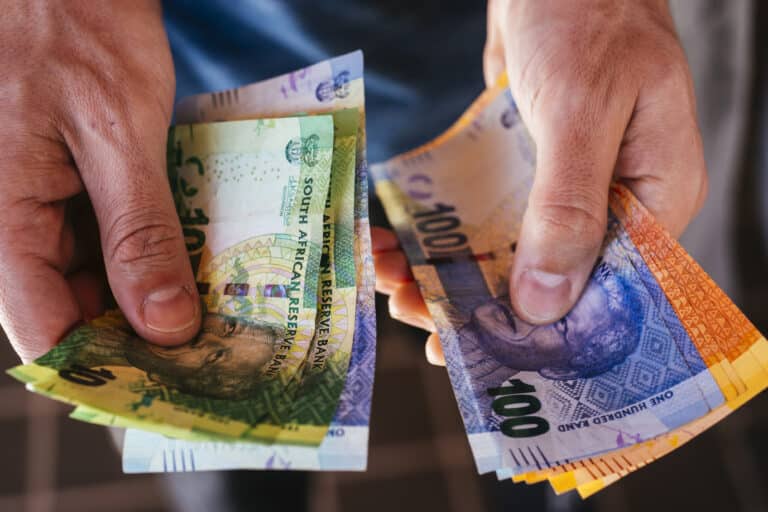
South Africa is renowned for its complex history, breathtaking landscapes, rich musical heritage, inspiring leaders such as Nelson Mandela, and its vibrant rand currency. But there’s more to South African money than just its colourful banknotes.
What Currency Does South Africa Use?
South Africa introduced the rand (ZAR) as its official currency in 1961, replacing the British pound. This transition coincided with the country becoming a republic and adopting the decimal system.
Here’s everything you need to know about the South African rand, including its history, design, and how you can use it effectively.
Introducing the South African Rand
The rand (abbreviated ZAR or R) is South Africa’s official currency. It’s divided into 100 cents and comes in both coins and banknotes. The South African Reserve Bank (SARB), based in Pretoria, oversees its issuance and circulation.
The SARB, established in 1921, is the oldest central bank in Africa. It manages the design and production of coins and banknotes through its subsidiary, the South African Bank Note Company (SABN).
Send and Receive Money Internationally in the UK with Remitly.
Get started with our free mobile app.
Download
Coins in Circulation
South African coins come in three distinct colours, representing different denominations:
- Red coins (1c, 2c, 5c): Feature birds, made of steel with a copper alloy coating.
- Yellow coins (10c, 20c, 50c): Feature flowers, made of steel with a copper and tin coating.
- White coins (R1, R2, R5): Feature antelopes, made of steel with a nickel coating.
Banknotes in Circulation
The current series of South African banknotes includes Nelson Mandela on the front and one of the “Big Five” animals on the back:
- R10 (green): Rhinoceros
- R20 (brown): Elephant
- R50 (red): Lion
- R100 (blue): Cape buffalo
- R200 (orange): Leopard
A special centenary series released in 2018 features Mandela’s life milestones on the back instead of the Big Five animals.
Six Fascinating Facts About the Rand
- Banknotes Feature 11 Languages
South Africa’s diverse cultural heritage is reflected in its currency, with each banknote displaying a combination of the country’s official languages. - The First Currency in South Africa Was Dutch
Dutch settlers introduced the guilder in the 1600s, which was later replaced by the British pound. The South African pound remained in use until the rand was introduced in 1961. - Older Banknotes Are Still Legal Tender
The SARB allows older banknotes to remain valid, ensuring you can exchange even decades-old notes for their face value. - The R100 Note Features Robben Island
The reverse of the R100 note commemorates Robben Island, where Nelson Mandela was imprisoned for 18 years. - The Rand’s Name Reflects South Africa’s Geography
“Rand” comes from the word “Witwatersrand,” meaning “white waters’ ridge,” which refers to the region where Johannesburg is located and where much of South Africa’s gold originates. - The Rand Is Used Beyond South Africa
The rand is also legal tender in Eswatini, Lesotho, and Namibia, as part of the Southern African Common Monetary Area.
Foreign Exchange and the Rand
The rand’s value is influenced by South Africa’s trade relationships, particularly with China and Europe, and by fluctuations in the global foreign exchange market.
Factors such as economic policies, political stability, and global commodity prices, including gold, play a role in the rand’s performance.
How to Use Money in South Africa
South Africa has a well-developed banking system, with ATMs and card payment facilities widely available. Major credit card providers like Visa and Mastercard make transactions convenient for visitors. However, it’s wise to check exchange rates and consider any international transaction fees.
Quick Tips for Using the Rand:
- Exchange currency at reputable providers to get the best rates.
- Use a currency converter to calculate accurate exchange rates in real time.
- Avoid carrying large amounts of cash for safety.
Frequently Asked Questions (FAQ)
What is the currency used in South Africa?
South Africa uses the rand (ZAR), which is divided into 100 cents.
Where can I exchange money for South African rand?
You can exchange money at banks, currency exchange offices, and international airports. For the best rates, avoid exchanging money at hotels or tourist hotspots.
Can I use US dollars or British pounds in South Africa?
No, South Africa primarily uses the rand for transactions. However, some tourist areas may accept major foreign currencies at a lower exchange rate.
Are credit cards widely accepted in South Africa?
Yes, credit cards like Visa and Mastercard are widely accepted, especially in urban areas. However, it’s good to carry some cash for small purchases or when travelling to rural regions.
Is the rand used outside South Africa?
Yes, the rand is legal tender in Eswatini, Lesotho, and Namibia as part of the Southern African Common Monetary Area.
